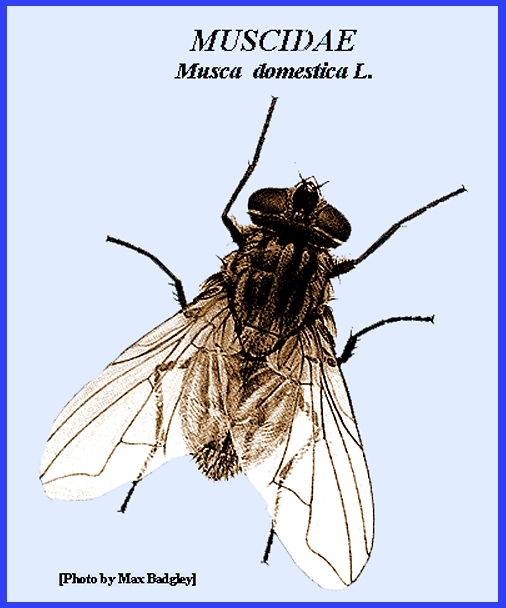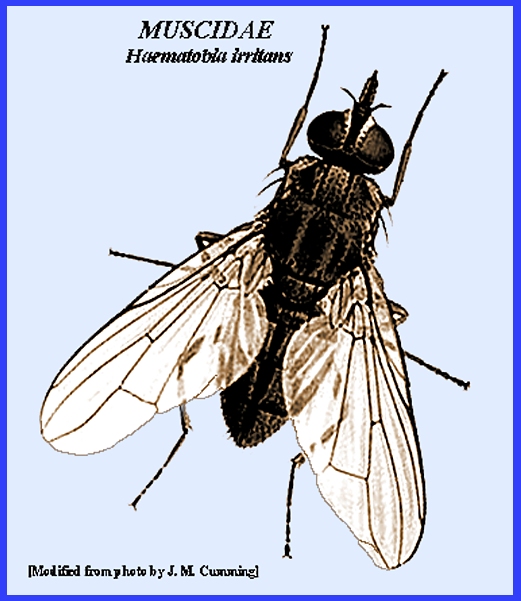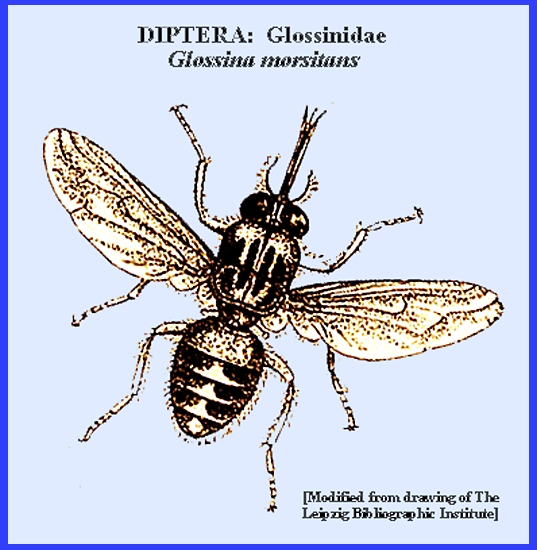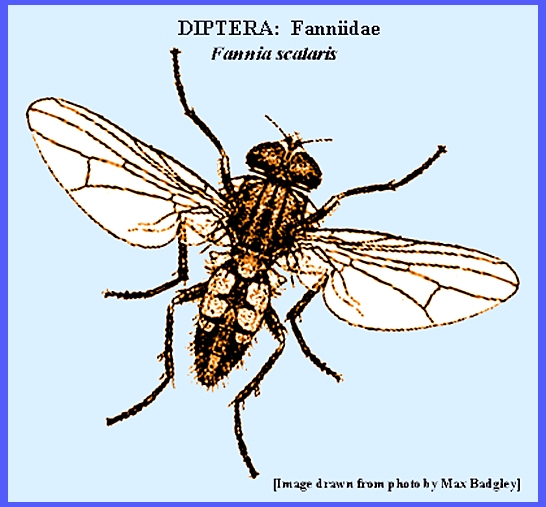File: <muscidaemed.htm> <Medical
Index> <General Index> Site Description Glossary <Navigate to
Home>
|
Arthropoda:
Hexapoda: Insecta: Diptera MUSCIDAE, FANNIIDAE & GLOSSINIDAE (Contact) Please CLICK on
Images & underlined links to view: Use Ctrl/F to search for subjects: The importance of this family as
serious pests and vectors of diseases has led to several biological control
projects to contain them (see bc-37.htm). Muscidae.-- The housefly, Musca domestica L., lays its eggs in decaying vegetable matter or animal
excrement. . The legless larvae are maggots with mouth
hooks, caudal and thoracic spiracles.
Their filthy habits of regurgitating saliva and food cause them to be
vectors of typhoid, cholera, and dysentery. etc. Either feces or regurgitations cause the flyspecks often found
on surfaces. Houseflies have been the
target of biological control in California and elsewhere (see ch-50.htm) The stable fly, Stomoxys calcitrans (L.) can breed in vegetable matter. The adult's mouthparts are of the biting
type, and the adults resemble houseflies, but are grayer in color. The hornfly, Haematobia irritans (L.) is also similar to the housefly but much smaller. It is a pest of cattle primarily and
breeds in cattle dung. Glossinidae.-- Tsetse flies, Glossina spp., are confined to the African Continent and
Arabia where they are vectors of trypanosomes that cause Sleeping Sickness and related diseases of humans and
animals. They are distinguished by
having their proboscis held straight forward and by having a a forewing cell
in the shape of a cleaver. These large, noisy flies may cause severe bites on humans with
resultant swellings. In East Africa
they are especially prevalent around streams. Fanniidae.-- Little house
flies. Fannia spp., breed in large numbers in animal dung, and are
especially numerous around poultry farms where they breed in such high
numbers as to invade surrounding areas causing annoyance to residents. They appear as small houseflies hovering
in huge masses. Their larvae are
distinctively flattened with many protuberances
on the periphery. They have been the target of biological control in
California and elsewhere (see ch-50.htm) = = = = = = = = = = = =
= = = = = = = = Key References: <medvet.ref.htm>
<Hexapoda> [Additional references may be found at: MELVYL Library] Barin, A., F. Arabkhazaeli, S. Rahbari
& S. A. Madani. 2010. The housefly, Musca domestica, as a possible mechanical
vector of Newcastle disease
virus in the laboratory and
field. Med. Vet. Entomol., 24(1):
88–90. Barnard, D R; Geden, C J. 1993.
Influence of larval density and temperature in poultry manure on
development of the house fly (Diptera: Muscidae.
Environ. Entomol., v.22, n.5,
(1993): 971-977. Brown, B.V. 2001. Flies, gnats, and mosquitoes.. In Encyclopedia
of Biodiversity, Volume 2. Academic Press. pp. 815-826 Brown, B. V., A. Borkent, J. M. Cumming, D. M. Wood,
N.E. Woodley & M. Zumbado.
2009. Man. Cent.Amer. Diptera,
Vol. 1, NRC Research Press,
Ottawa. Chillcott, J. G.
1961. A revision of the
Nearctic species of Fanniinae (Diptera: Muscidae). Canad. Entomol Suppl, 14(1): 295 Couri, M. S.
2005. An illustrated key to
adult males of neotropical Fannia Robineau-Desvoidy belonging to pusio
sub-group (Diptera,
Fanniidae). Brasil J. Biol, 65(4):
625–629 De Jesus, A. J., A. R. Olsen & J. R. Bryce. 2004. Whiting Quantitative contamination and transfer of Escherichia coli from food by houseflies,
Musca
domestica L
(Diptera:Muscidae). Int. J. Food Microbiol,
193: 259–262 Forster, M., S. Klimpel, H. Mehlhorn, K. Sievert, S. Messler & K.
Pfeffer. 2007. Pilot study on synanthropic flies
(e.g. Musca, Sarcophaga, Calliphora, Fannia, Lucilia and Stomoxys) as vectors of pathogenic microorganisms. Parasitol Res, 101(1):
243–246, Geden, C J; Rutz, D
A; Steinkraus, D C. 1995. Virulence of different isolates and
formulations of Beauveria bassiana
for house flies and the parasitoid Muscidifurax raptor.Biological
Control, v.5, n.4, (1995): 615-621. Geden, C J;
Steinkraus, D C; Rutz, D A. 1993. Evaluation of two methods for release of Entomophthora muscae (Entomophthorales: Entomophthoraceae) to infect house flies (Diptera: Muscidae) on dairy
farms. Environ. Entomol., v.22, n.5, (1993):
1201-1208. Geden, C J;
Steinkraus, D C; Rutz, D A. 1993. Evaluation of two methods for release of Entomophthora muscae (Entomophthorales: Entomophthoraceae) to infect house flies (Diptera: Muscidae) on dairy
farms. Environ. Entomol., v.22, n.5, (1993):
1201-1208. Geden, C. J. 1984. Population dynamics, spatial distribution, dispersal behavior
and life history of the predaceous histerid, Carcinops pumilio
(Erichson), with observations of other members of the
poultry manure arthropod community.
Ph.D. disser, Dept. of Entomology, Univ. of Mass., Amherst. 220 p. Geden, C. J. 1990. The role of coleopteran and acarine predators in house fly
population regulation in poultry production facilities, p. 177-200. In: D. A. Rutz & R. A. Patterson (eds.),
Biocontrol of Arthropods Affecting Livestock and Poultry. Westview Press, Boulder, CO. Geden, C. J. &
D. A. Rutz. 1991a. Using parasitic wasps to manage
insecticide-resistant house flies.
Fact Sheet. 2 p. Geden, C. J. &
J. G. Stoffolano, Jr. 1987. Succession of manure arthropods at a
poultry farm in Massachusetts, with notes on Carcinops pumilio
sex ratios, ovarian condition and body
size. J. Med. Ent. 24: 214-22. Geden, C. J. &
J. G. Stoffolano. 1988. Dispersion patterns of arthropods
associated with poultry manure in enclosed houses in Massachusetts: spatial distribution and effects of
manure moisture and accumulation time.
J. Ent. Sci. 23: 136-48. Geden, C. J. &
R. C. Axtell. 1988a. Predation by Carcinops pumilio
(Coleoptera: Histeridae) and Macrocheles
muscaedomesticae
(Acarina: Macrochelidae) on the housefly
(Diptera: Muscidae): Functional
response, effects of temperature and availability of alternative prey. Environ. Ent. 17: 739-44. Geden, C. J., R. F.
Stinner & R. C. Axtell. 1988. Predation by predators of the house fly in
poultry manure: effects of predator
density, feeding history, interspecific interference and
field conditions. Environ. Ent.
17: 320-29. Gheibi, M. & H Ostovan. 2009. Preliminary investigation on the Tachinid flies in
Fasrs province in Iran. Plant Prot J,
2(1): 140–166. Gregor, F. R. et al., 2002 The Muscidae (Diptera) of
Central Europe, Brno, Folia Biologia, 107. Hall, M. J., A.H. Wardhana, G. Shahhosseini & Z.
J. Adams. 2009. Genetic diversity of populations of
Old World screw worm fly, Chrysomya bezziana, causing
traumatic myiasis of livestock in the Gulf region and implications for
control by sterile insect technique.
Med. Vet. Entomol,
23 (Supp 11): 51–58 Hennig, W. 1955–64. Muscidae
IN: Erwin Lindner, Die Fliegen der Paläarktischen Region 63b, Schweizerbart,
Stuttgart. Hinkle, Nancy C., D. Craig Sheppard,
and Maxcy P. Nolan, Jr. 1985. Comparing residue exposure and topical
application techniques for
assessing permethrin resistance
in house flies (Diptera: Muscidae). J. Econ. Ent. 78:
722-724. Huckett, H.C. 1965.
The Muscidae of northern Canada, Alaska and Greenland (Diptera).
Memoirs Entomol. Soc. of Canada 42: 1-369. James, M. T.
1947. The flies that cause
myiasis in man, US Government Printing Office, Washington, p. 228 Khoobdel, M., A. Mehrabi Tavana, H. Vatandoost &
M. R. Abaei. 2008. Arthropod borne diseases in imposed
war during 1980-88. Iran J
Arthropod-Born Dis, 2(1):
24–32 Khoobdel, M., S.M.A. Seyedi Rashti, M. Shayeghi &
S. Tirgari. 2004. The survey fauna of
Calliphoridae and Sarcophagidae flies in Tehran and
suburb. J. School Publ Health
Inst. Publ. Health Res, 8(2): 79–83 Khoobdel, M., N. Jonaidi & M. Seiedi Rashti. 2008.
Blowfly and flesh (Diptera: Cyclorrhpha) fauna in Tehran,
Iran J. Entomol, 5(3): 185–192 Lane, R. P. & R. W. Crosskey. 1993.
Medical insects and arachnids, Chapman and Hall, London,
pp. 211–228 Matheson, R. 1950.
Medical Entomology. Comstock
Publ. Co, Inc. 610 p. Service, M.
2008. Medical Entomology For
Students. Cambridge Univ. Press. 289 p Legner, E. F. 1995. Biological control of Diptera of medical and veterinary
importance. J. Vector Ecology 20(1):
59-120. Legner, E. F. 2000.
Biological control of aquatic Diptera. p. 847-870.
Contributions to a Manual of Palaearctic Diptera, Vol. 1, Science Herald,
Budapest. 978 p. McAlpine, J. F., B. V. Peterson, G. E. Shewell, J. R.
Vockeroth & D. M. Wood.
1987. Manual of Nearctic
Diptera, 2 Vols, Research Branch, Agric. Canada,
Monogr. No. 27 & 28. Lang, M. D., G. R. Allen & B. J.
Horton. 2006. Blowfly succession from possum (Trichosurus
vulpecula) carrion in a sheep-farming zone.
Med. Vet.
Entomol, 20(4) : 445–452 Monteiro, M. R.,
& A.P. do Prado.
2006. Synanthropic flies
(Diptera: Cyclorrapha) and their microhymenoptera parasitoids (Insecta:
Hymenoptera) at Monte Mor
poultry production system, São Paulo, Brazil. Rev. Brasil Parasitol. Vet., 15(2): 49–57 Mullens, B. A., N. C. Hinkle, C. A.
Szijj and D. R. Kuney. 2001. Managing manure and conserving predators
helps control flies in caged-layer
poultry systems. California
Agriculture 55(5): 26-30. Mullens, B.A., C.E. Szijj and N.C.
Hinkle. 2002. Oviposition and development of Fannia spp. (Diptera: Muscidae) on
poultry manure of low
moisture levels. Environ.
Entomol. 31(4): 588-593. Mullens, B. A., N. C. Hinkle, C. A.
Szijj and D. R. Kuney. 2001. Managing manure and conserving predators
helps control flies in caged-layer
poultry systems. Calif. Agric.
55(5): 26-30.
Mullens, B.A., N.C. Hinkle and C.E.
Szijj. 1996. Impact of alternating manure removal
schedules on pest flies (Diptera: Muscidae) and
associated predators
(Coleoptera: Histeridae, Staphylinidae; Acarina: Macrochelidae) in
caged-layer poultry manure in southern
California. J. Econ. Ent.
89(6): 1406-1417 Mullens, B.A., N.C. Hinkle and C.E.
Szijj. 1996. Role of the poultry manure pad in manure
drying and its potential relationship to filth fly
control. J. Agric. Entomol.
13(4): 331-337. Namazi, M. R. & M. K. Fallahzadeh. 2009.
Wound myiasis in a patient with squamous cell
carcinoma. Sci World J, 1(9):
1192–1193 Oldroyd, H. 1964. The natural history of flies.
Weidenfeld and Nicolson, London. 324 pp. Oldroyd, H.
1970. Diptera 1: Introduction
and key to families. Handbook for the identification of British insects (3rd
ed.), Roy. Ent. Soc. London. Pickens, L. G. &
R. W. Miller. 1980. Biology and control of the face
fly, Musca autumnalis (Diptera:
Muscidae). J Med Entomol,
17(3): 195–210. Pont, A. C. 2002. The Fanniidae (Diptera)
described by J.W. Zetterstedt. Insect
Syst Evol, 33(1): 103–112 Pont, A. C., D. Werner & E.A.
Kachvoryan. 2005. A preliminary list of the Fanniidae
& Muscidae (Diptera) of Armenia.
Zoology in the Middle East,
36:364–378. Séguy, E. 1937. Diptera, family
Muscidae. In: P. Wystmann (ed.), Genera
Insectorum, Brussels, 205: 604. Shinonaga, S. & R. Kano. 1971.
Fauna Japonica Muscidae (Insecta:Diptera). Academia Press. 242 pp. Shoorijeh, S. J.,
S. Negahban, A. Tamadon & M.A. Behzadi. 2009. Prevalence and intensity
of Oestrus ovis in sheep of Shiraz, southern Iran. Trop
Anim. Health Prod, 41 (7): 1259–1262 Six, D. L. and B. A. Mullens. 1996.
Seasonal prevalence of Entomophthora
muscae and attempted introduction of Entomophthora schizophorae
(Zygomycotina:
Entomophthorales) into Musca domestica (Diptera: Muscidae)
populations on California dairies. Biological Control 6:
315-323.76. Skevington, J.H. & P. T. Dang, eds. 2002.
Exploring the diversity of flies (Diptera). Biodiversity 3(4): 3-27. Watson, D W; Geden, C J; Long, S J; Rutz, D A. 1995.
Efficacy of Beauveria bassiana for controlling the house fly and
stable fly (Diptera: Muscidae). Biological Control, v.5, n.3,
(1995): 405-411. |
FURTHER DETAIL = <Entomology>, <Insect Morphology>, <Identification Keys>





